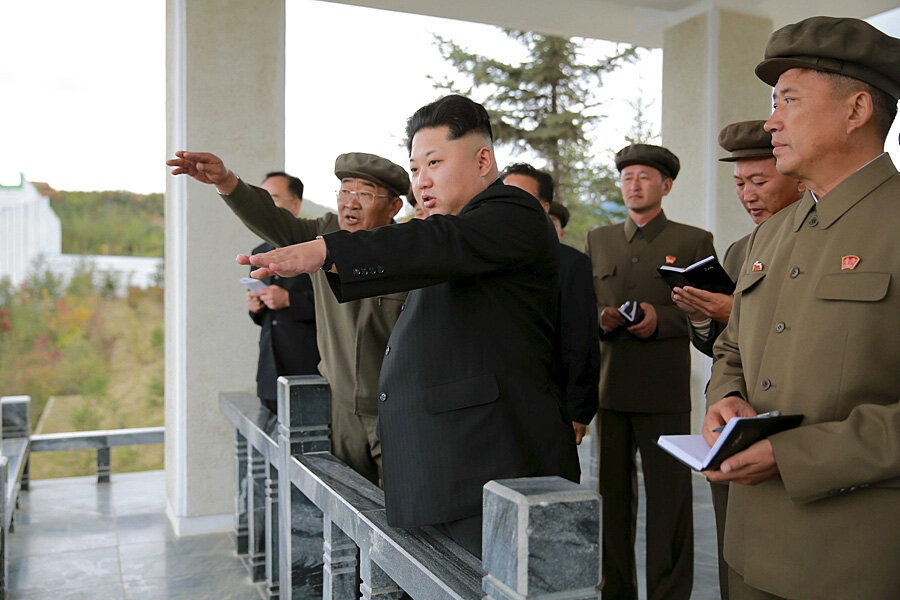Is the US prepared for a nuclear threat from North Korea?
Loading...
North Korea is "fully ready" to launch nuclear weapons against the US or other "hostile forces," said a Korean official on Tuesday.
And the US is ready to respond, say Pentagon officials.
"If the US and other hostile forces persistently seek their reckless hostile policy towards the DPRK [Democratic People’s Republic of Korea]," said an unnamed atomic energy official on the North’s state-run Korean Central News Agency, "the DPRK is fully ready to cope with them with nuclear weapons any time."
This statement comes some three weeks after North and South Korea reached an agreement to dial back tensions along the Demilitarized Zone, which saw land mine blasts and an exchange of artillery fire in August. But the newly minted agreement did not address Pyongyang's nuclear program, to the dissatisfaction of some US officials.
"The threat was not unusual for North Korea. But it’s bound to heighten concerns that the country’s leader, Kim Jong-un, is preparing for a nuclear test or long-range ballistic missile launch when the regime commemorates the 70th anniversary of its ruling Workers’ Party on Oct. 10," reported The Christian Science Monitor's Michael Holtz.
As North Korean troops began to mobilize in late August, US commanders at the Pentagon met with South Korean military officials to review South Korea's defense plan. They discussed "what US forces are available if needed, and what actions by North Korea would trigger a US military response," CNN reported.
Pentagon officials say the US military is fully prepared to handle a North Korean threat if it were to arise and that they have taken precautionary measures to limit and de-escalate tensions.
"We've moved, over time, a good deal of missile defense capability to the region," US Ambassador to South Korea Mark Lippert said in an interview with CNN. "Ground-based interceptors to Alaska, surface combatants to the Western Pacific, a THAAD [Terminal High Altitude Area Defense] battery on Guam, another radar in Japan in order to be ready and vigilant for anything the North Koreans may or may not do."
South Korea is taking its own preventative measures, including buying 12 refurbished US S-3 Viking anti-submarine warfare (ASW) planes.
North Korea does appear to be stepping up its nuclear presence. American and South Korean intelligence officials are closely monitoring Yongbyon, the nuclear reactor complex north of Pyongyang that shut down as part of a 2007 nuclear disarmament deal, and which officials vowed to restart after the deal collapsed in 2013, reported The New York Times.
The International Atomic Energy Agency (IAEA) reports some activity at the plant, but is unable to determine if it is operating at full capacity, since IAEA inspectors have not had access since 2009.
"We have observed renovation and construction activities at various locations within the site," IAEA Director General Yukiya Amano said on Sept. 7, according to Reuters. "These appear to be broadly consistent with the DPRK's statements that it is further developing its nuclear capabilities," he said.
North Korea has been following the same playbook for decades, noted the Monitor's Editorial Board in late August: Provoke a crisis with South Korea or the US and then demand appeasement to restore a truce. But in August, South Korea didn't play along, responding with artillery fire instead of concessions.
"Has the cycle of provoke-and-demand-a-reward finally been broken? It may be too soon to tell," write the editors. "South Korea may have at last found the right balance of strength and magnanimity in how it responds to North Korea’s playbook of pointless ploys."
Whether North Korea's nuclear claims are another "pointless ploy" remains to be seen, but North Korea would have no chance of victory if they attempted an attack, said US Defense Secretary Ashton Carter in a Sept. 1 webcast.
"We need to make sure that the North Koreans always understand that any provocation with them will be dealt with and that they stand no chance of defeating us and our allies in South Korea," he said.







